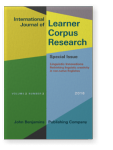The fate of linguistic innovations
Jersey English and French learner English compared
Drawing on spoken corpus data, this study traces the emergence and development of Norman French-influenced innovations in the nativised L2 variety of Jersey English and compares them to features in the speech of French-speaking learners of English. The comparison shows that such innovations do not differ from errors in a learner variety on a formal linguistic level and that they arguably result from the same processes as are present in foreign language acquisition, such as transfer or simplification. The paper therefore argues that innovations can only be identified reliably in retrospect, once they are more widely accepted in the speech community. It also points to the social factors that are crucial in shaping the use and probable fates of former innovations in Jersey English and suggests a typology of innovations according to their developments.
References (41)
Barbé, P. 1993. Exploring Variation in Guernsey English Syntax. PhD dissertation, University of London.
Biber, D., Conrad, S. & Leech, G. 2002. The Longman Student Grammar of Spoken and Written English. Harlow: Pearson Longman.
British National Corpus. Version 4.3 (BNCweb CQP-edition). 2013. Developed by S. Hoffmann and S. Evert. Available at [URL].
Bruthiaux, P. 2003. “Squaring the circles: Issues in modeling English worldwide”, International Journal of Applied Linguistics 13(2), 159–178. 

Davydova, J. 2012. “Englishes in the Outer and the Expanding Circles: A comparative study”, World Englishes 31(3), 366–385. 

De Cock, S., Granger, S., Leech, G. & McEnery, T. 1998. “An automated approach to the phrasicon of EFL learners”. In S. Granger (Ed.), Learner English on Computer. London: Longman, 67–79.
Dubois, S. & Horvath, B. 2008. “Cajun Vernacular English: Phonology”. In E. Schneider (Ed.), Varieties of English 2. The Americas and the Caribbean. Berlin: Mouton de Gruyter, 208–218.
Gilquin, G. 2011. “Corpus linguistics to bridge the gap between World Englishes and Learner Englishes”, Communicación en el siglo XXI 21: 638–642.
Gilquin, G., De Cock, S. & Granger, S. (Eds.). 2010. Louvain International Database of Spoken English Interlanguage (CD-ROM + Handbook). Louvain-la-Neuve: Presses universitaires de Louvain.
Gold, E. 2008. “Canadian eh? From eh to zed”, Anglistik 19(2), 141–156.
Jones, M.C. 2001. Jersey Norman French: A Linguistic Study of an Obsolescent Dialect. Oxford: Blackwell.
Jones, M.C. 2010. “Channel Island English”. In D. Schreier, P. Trudgill, E. Schneider & J. Williams (Eds.), The Lesser-Known Varieties of English. An Introduction. Cambridge: Cambridge University Press, 35–56. 

Kachru, B. 1982. “Models for non-native Englishes”. In B. Kachru (Ed.), The Other Tongue. English across Cultures. Urbana, Chicago and London: University of Illinois Press, 31–57.
Kachru, B. 1985. “Standards, codification and sociolinguistic realism: The English language in the outer circle”. In R. Quirk & H. Widdowson (Eds.), English in the World: Teaching and Learning the Language and Literatures. Cambridge: Cambridge University Press, 11–30.
Kachru, Y. & Nelson, C. 2006. World Englishes in Asian Contexts. Aberdeen and Hong Kong: Hong Kong University Press.
Krug, M. & Rosen, A. 2012. “Standards of English in Malta and the Channel Islands”. In R. Hickey (Ed.), Standards of English – Codified Varieties around the World. Cambridge: Cambridge University Press, 117–138. 

Le Ruez, N. 2003. Jersey Occupation Diary. Her Story of the German Occupation, 1940–1945. Bradford on Avon: Seaflower Books.
Macaulay, R. 1989. “He was some man him: Emphatic pronouns in Scottish English”. In T. Walsh (Ed.), Synchronic and Diachronic Approaches to Linguistic Variation and Change. Washington DC: Georgetown University Press, 179‒187.
Mesthrie, R. 1992. English in Language Shift. The History, Structure and Sociolinguistics of South African Indian English. Cambridge: Cambridge University Press.
Mesthrie, R. & Bhatt, R.M. 2008. World Englishes. The Study of New Linguistic Varieties. Cambridge: Cambridge University Press. 

Nelson, C. 1982. “Intelligibility and non-native varieties of English”. In B. Kachru (Ed.), The Other Tongue. English across Cultures. Urbana, Chicago and London: University of Illinois Press, 58–73.
Ramisch, H. 1989. The Variation of English in Guernsey/Channel Islands. Frankfurt am Main: Lang.
Schneider, E. 2003. “The dynamics of New Englishes: From identity construction to dialect birth”, Language 79(2), 233–281. 

Schneider, E. 2007. Postcolonial English. Varieties around the World. Cambridge: Cambridge University Press. 

Scott, M. 2008. WordSmith Tools version 5. Liverpool: Lexical Analysis Software.
Sridhar, K. & Sridhar, S. 1986. “Bridging the paradigm gap: Second language acquisition research and indigenized varieties of English”, World Englishes 5(1), 3–14. 

Viereck, W. 1988. “The Channel Islands: an Anglicist’s no-man’s land.” In J. Klegraf & D. Nehls (Eds.), Essays on the English Language and Applied Linguistics on the Occasion of Gerhard Nickel’s 60th Birthday. Heidelberg: Groos, 468–478.
Cited by (2)
Cited by two other publications
Ndoci, Rexhina
2023.
An Albanian Ethnolect of Modern Greek? Testing the Waters Perceptually.
Languages 8:1
► pp. 20 ff.

This list is based on CrossRef data as of 4 july 2024. Please note that it may not be complete. Sources presented here have been supplied by the respective publishers.
Any errors therein should be reported to them.
